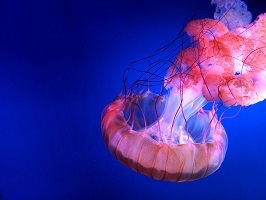- 01843 834160
- [email protected]
- Mon - Fri: 9:00 - 17:00
With the warmer weather comes the Jellyfish!

Residents and tourists alike are being told to exercise caution in the sea and on the sand, as the recent warmer weather has brought with it an influx of Jellyfish.
They can usually be found in warm water and are easily spotted in the shallow waters near beaches. If you spot one in the water, don’t worry, just move out of its way. If you see a large group of them, known as a bloom, get out of the water.
There are over 200 species of Jellyfish, with lots more that are similar, but only about six that regularly found along Britain’s coast.
The types of Jellyfish you will find around the UK include:

The Moon Jellyfish. Very common with a very minor sting.
Moon Jellyfish. These are the most common Jellyfish found. Their sting is very mild but can still cause rashes and discomfort. They are distinguishable by the 4 petal-shapes on its bell.
Lions mane Jellyfish. The Lions Mane Jellyfish is world largest jellyfish and can grow to 8 feet across, with tentacles that can stretch anywhere from 30-120 feet in length. Their sting can be very painful. They can be identified by their orange or reddish brown bell, with thin tentacles all gathered in a mass that resembles a lion’s mane.
Compass Jellyfish. These are recognisable by the dark compass markings, which look like a brown frilly skirt and brown lines across the top. Their sting feelings like nettles.
Blue Jellyfish Aptly named, and easily identified, these guys are bright blue. Sting feels like nettles too.
Dustbin-lid jellyfish. These guys can grow to a whopping 90cm in diametre and are generally found in harbours. A gentle giant, it actually has a very weak sting.
Mauve stinger Also known as purple Jellyfish is a small but pretty jellyfish whose bell grows only to about 2 inches across. They have a purplish translucent bell that is dotted with red and long arms that trail behind them. Their asting is particularly nasty, with nausea and symptoms similar to hives.

The Portuguese man-of-war, which can sometimes wash up on British beaches.
Other Jellyfish that have been spotted, and should be given a wide birth include box jellyfish (which look like a box if viewed from above, and the Portugese man o’ war. While not technically a Jellyfish, these ugly looking creatures have a nasty sting but are not usually fatal. They are easily identified, with a blue, purple colouring, an inflated float and long trailing tentacles, which can stretch up to 50 feet.
And what if you are stung?
Don’t panic. Most Jellyfish found in British water give only minor stings.
That being said, be careful even if you think the Jellyfish washed up on the beach is dead, it can still sting for weeks after. Also, if you do see one on the beach, try to walk around it on the side opposite the sea, as tentacles could still be trailing or have become detached. If you are still worried, experts say you could wear a swimsuit when swimming in the water.
The NHS gives the following advice:
- If you are in the water, get out as soon as possible.
- Do not put anything on the sting, such as urine or vinegar. This is because it can be very hard to tell what type of Jelly has stung you and different stings react in different ways. It could make it worse rather than better.
- If there are tentacles attached, use something other than your hands to remove it. Tweezers or a credit card is best. They will cling to clothing.
- Wash the area with salt water or hot water to flush out the venom. Do not use cold water or apply ice to the sting as this could make the venom continue releasing in the system.
- Paracetamol can help with the pain.
- If there are any other symptoms such as extreme pain, swelling or symptoms of allergic reactions occur then seek medical help.
We need not fear these creatures, here’s just a few reasons why they are actually awesome:
- First of all, they are not actually fish, and are sometimes simply referred to as Jellies. A collective of Jellies is usually called a Swarm or Bloom.
- They are super old. The oldest fossil of one was found in Utah and dates back 500 million years.
-
A Crystal Jellyfish spotted in Margate
The Crystal Jellyfish, which sometimes wash up around England, is aptly named as it is Crystal clear, but also glows greenish-blue. This 10 inches creature is helping us massively with scientific research, thanks to the fluorescent proteins it uses, both of which are used in laboratory, clinical and molecular research. It is even being used to create early ways of detecting cancer.
- Most Jellyfish only have one entrance into their digestive system, so effectively their mouth is also their butt.
- They are totally laid back when it comes to movement, using currents to carry them instead of wasting energy. This sometimes means that they are at the mercy of winds, currents, and waves that carry them around, but they do have the ability to propel themselves by pulsing their bell, if needed.
- They don’t actually sting you, or bite you. The Jelly’s tentacles are lined with cells called nematocytes coiled up inside are nematocysts. When something brushes past against these they set off a tiny explosion and the nematocysts unravel before piercing the flesh with millions of microscopic needles. All in less than a 3rd of a second. Cool.
For more information on these incredible creatures, and help identifying the weird and wonderful varieties, head over to the Marine Conservation Society website: https://www.mcsuk.org/explore-and-discover/
Keep up to date with all CommunityAd articles, news and publications by following us on our social media channels:













